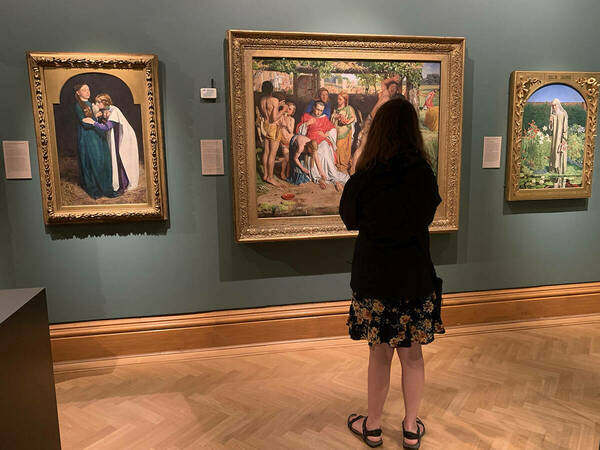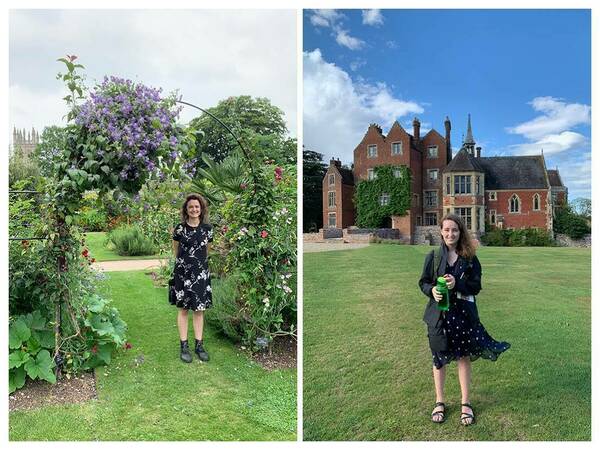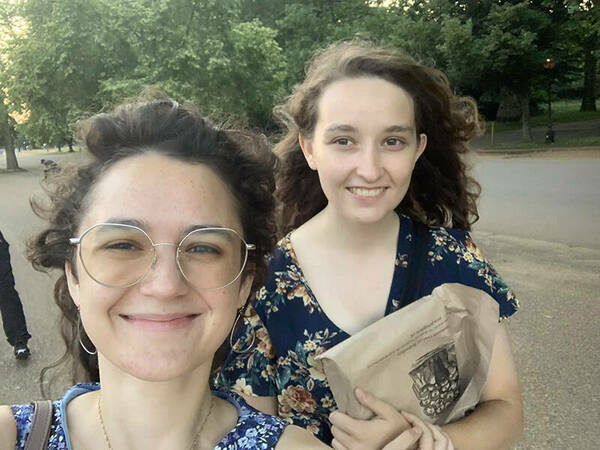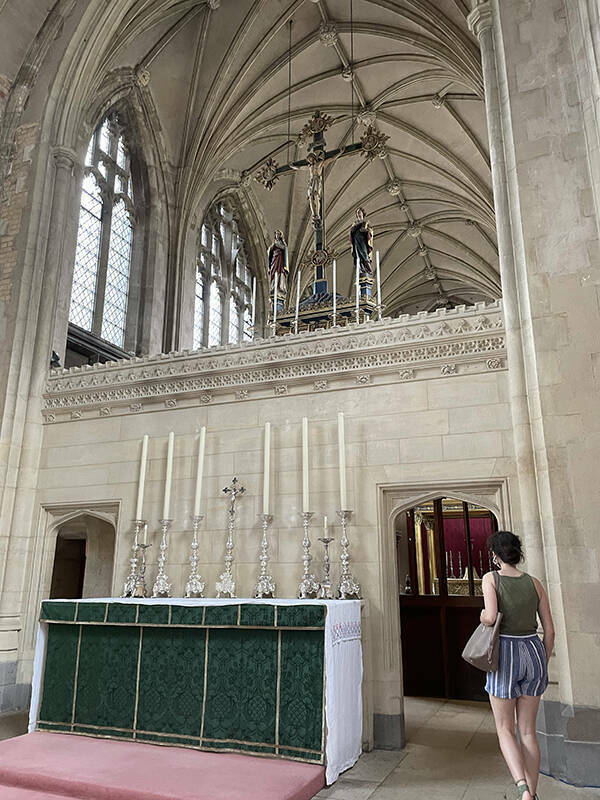
In the summer of 2021, Mary Biese ’22, a major in the Program of Liberal Studies with minors in theology and liturgical music ministry, and Maria Keller ’22, a major in the Program of Liberal Studies with a minor in medieval studies, received research and travel grants from the Nanovic Institute for European Studies to carry out research for their senior theses on 19th century English Catholic aesthetics. Having realized how much their individual projects intersected, the friends planned and undertook their research trips together. In this joint post, they share how everything worked out and relive a memorable month in England.
Mary Biese: I think this all started when we realized our thesis topics were much more related than we thought they were. We knew we wanted to study British authors, but we had no idea at first just how aesthetically and historically connected they were. I’m particularly interested in J.R.R. Tolkien and Gerard Manley Hopkins, both of whom loved writing about finding God in nature and wrestling with deep loss.
Maria Keller: Yes, and my interests lie in the work of Evelyn Waugh, a twentieth-century English Catholic satirist and novelist. I am particularly interested in his aesthetic philosophy and his relationship with 19th-century aesthetics. So, when you and I started talking through our theses together, we very quickly realized the overlap in our interests and in these authors. We were also both planning on going to London to study abroad and do research for our theses. When spring study abroad was canceled because of COVID, we realized we would have to search for another option because both of our theses depended on in-person research in England.
MB: I remember we started working on our grant proposals separately, and then we thought, “Why not just go together?” Since one part of Nanovic’s mission is to send students to Europe, we each applied to their grant program in March. We did a lot of collaborating to make our dates and locations line up, and sent in our applications. I was so nervous about whether it was going to work out, and a lot of the travel restriction changes meant the situation was very touch-and-go. Do you remember how closely we were watching for British travel regulation updates?

MK: Yes, it was very stressful. The restrictions did actually change not long after we arrived in the UK, but ultimately we only had to quarantine for a week, which wasn’t too bad, and we were still able to be in England for almost a month! Two weeks in London and one in Oxford was a good amount of time to see what we needed to see.
MB: I’m so glad we had time for a full week in Oxford. Almost all of the authors we were studying were there at some point or another. We got to see the arch where Tolkien sat when he was a professor at Oxford and many of the buildings that featured in Waugh’s Brideshead Revisited. At the V&A [the Victoria and Albert Museum] and at another church about an hour from London, we got to see a breathtaking collection of Pre-Raphaelite stained glass windows, which we just could not have viewed properly in a photograph. Wasn’t it absolutely phenomenal to be able to see all of these buildings and objects in person?
MK: Yes, it really was. I was thinking about this when we saw a number of Pre-Raphaelite paintings together—including Dante Rossetti’s Proserpine and Holman Hunt’s The Light of the World. You really can’t replicate the experience of being in the same room as this artwork. For example, you often can’t see the frames of these paintings when you look them up on, say, Google. A lot of Pre-Raphaelites crafted their frames with inscriptions and designs made specifically for a particular painting. I didn’t know this before seeing the artwork in real life.
MB: Do you think this immersive experience has affected how you’ll write your thesis?

MK: Yes! My immersion in this aesthetic atmosphere brought me closer to what I think Waugh would have experienced and ultimately helped inspire my central argument. Many of the Pre-Raphaelite and arts and crafts works that we visited, although naturalistic, were also highly contrived, as they often depict a pseudo-medieval aesthetic that was foreign to both the industrialized 19th-century English and to today’s minimalist world. My thesis addresses how, in Brideshead Revisited, Waugh depicts artificiality and self-creation as either self-destructive or sanctifying, depending on its direction.
MB: Doing the trip together was a huge blessing as well. For one thing, it meant we could take turns navigating and taking pictures.
MK: We were able to split the costs of food and lodging as well! And, as we have similar interests and our theses are historically and thematically linked, we could bounce ideas off each other—those ideas that come into your head immediately after you walk out of a gallery or at random times over dinner or on the train. I also thought it was really helpful that as we explored various museums together, we were able to train each other to identify Pre-Raphaelite paintings, saying, “I bet that’s one!” and then look up the history of a few of the paintings and their creators.
MB: And it was lovely just generally to share our excitement about everything we encountered, and to share those experiences. Standing outside of the Inklings’ pub [The Eagle and Child] where Tolkien and C.S. Lewis would have sat, going to Mass in the church Tolkien attended for so many years, and visiting his favorite botanical gardens in Oxford were such delightful and memorable experiences.
MK: Of course, things didn’t always work out. Learning how to use buses was a major learning curve for both of us.

MB: Probably because neither of us had ever ridden a public bus before since we are both from the suburbs! We assumed that it worked like the [London] Underground—that it stopped at each stop no matter what. Do you remember the first time we got the bus? We missed our stop and had to walk in the opposite direction once the bus driver realized what had happened and let us get off. The next time, we missed our stop again and, although we were tempted to just walk back in the correct direction, there was no sidewalk so we just waited for the next bus to come and pick us up. It was a very new and somewhat stressful experience, but we figured it out eventually.
MK: To go back to what we were saying about the importance of the immersive experience: since my thesis focuses on English Catholic aesthetics, I felt so lucky to be able to spend so much time inside some of the churches that directly inspired the work I’m interested in. My personal favorite part of the trip was a visit to Madresfield Court, to see the chapel that inspired the Flyte family’s chapel in Brideshead Revisited. It was so inspiring to imagine Waugh sitting in that same space when he was developing his masterpiece.
MB: And I think my favorite was visiting the London Oratory, which was right next to one of the main museums. We went to Mass there towards the beginning of the trip and loved it so much that we returned for adoration on the last day of our trip when we revisited the museum next door. One of my pictures from the church is currently the screensaver for my phone. I’ll never quite forget its grandeur. Gerard Manley Hopkins, one of the figures I’m studying for my thesis, says that “the world is charged with the Grandeur of God.” And that was definitely true on our trip.
Originally published by at nanovicnavigator.nd.edu on January 21, 2022.